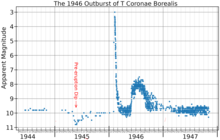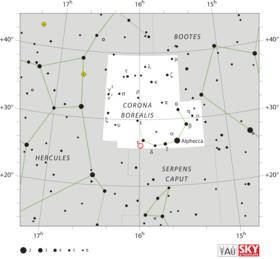北冕座T
| 觀測資料 曆元 J2000 | |
|---|---|
| 星座 | 北冕座 |
| 星官 | |
| 赤經 | 15h 59m 30.1622s[1] |
| 赤緯 | 25° 55′ 12.613″[1] |
| 視星等(V) | 2.0–10.8[2] |
| 特性 | |
| 演化階段 | 紅巨星 + 白矮星 |
| 光譜分類 | M3III+p[3] |
| 變星類型 | 再發新星[2] |
| 天體測定 | |
| 徑向速度 (Rv) | −27.79[4] km/s |
| 自行 (μ) | 赤經:−4.220[5] mas/yr 赤緯:12.364[5] mas/yr |
| 視差 (π) | 1.2127 ± 0.0488[5] mas |
| 距離 | 806+34 −30[6] pc |
| 軌道 | |
| 繞行週期 (P) | 227.8 d[7] |
| 半長軸 (a) | 0.54 AU[6] |
| 偏心率 (e) | 0.0[7] |
| 傾斜角 (i) | 67[8]° |
| 詳細資料 | |
| 紅巨星 | |
| 質量 | 1.12[6] M☉ |
| 半徑 | 75[8] R☉ |
| 表面重力 (log g) | 2.0[9] |
| 亮度 | 655[10] L☉ |
| 溫度 | 3,600[9] K |
| 白矮星 | |
| 質量 | 1.37[6] M☉ |
| 亮度 | ~100[8] L☉ |
| 其他命名 | |
| 參考資料庫 | |
| SIMBAD | 資料 |
北冕座T(T Coronae Borealis,縮寫T CrB)是位於星座北冕座的一顆再發新星[11]。它最早是由約翰·伯明罕 (天文學家)在1866年爆發時發現的[12],然而它早些時候被觀測到是一顆10等星[13]。它可能在1217年和1787年被觀測到[14][15]。
描述
[編輯]
北冕座T的星等通常約為10等,接近典型雙筒望遠鏡的極限。 之前曾觀察過它兩次爆發,分別在1866年5月12日和1946年2月9日,視星等分別達到2.0等和3.0等[16]。然而,最近的一篇論文顯示,1866年的爆發可能具有2.5等的峰值範圍,± 0.5[17]。即使在2.5等的峰值星等下,這顆再發新星也比夜空中大約120顆恆星還要暗[18]。它有時被暱稱為「烈焰之星」[19]。
北冕座T是一個 聯星系統,包含一顆巨大的低溫恆星和一顆緻密的高溫恆星。主星是一顆表面溫度較低的紅巨星,它正在將物質轉移到炙熱的伴星上。熾熱的伴星全部隱藏在來自紅巨星的密集物質雲中,是一顆被吸積盤環繞的白矮星。當系統處於寧靜狀態時,紅巨星主導可見光的輸出,系統呈現的恆星光譜為M3的巨星。熾熱的伴星會貢獻一些發射並主導紫外線的輸出。在爆發過程中,白矮星因為熱失控釋放出大量的能量,系統的光度因而暴增[6][8][20] [21]。

該系統的兩顆恆星每228天相互繞行一次。軌道幾乎是圓形的,傾斜角度為67°[6]。
2016年至今的活動
[編輯]2016年4月20日,天空與望遠鏡雜誌的網站報導,自2015年2月以來,它的亮度從10.5等持續變亮到約9.2等。1938 年,也有類似事件的報導,然後在1946年發生了爆發[22]。到2018年6月,這顆恆星略微變暗,但仍保持著異常高的活動水準。在2023年3月或4月,它變暗至12.3等[23]。1946年爆發的前一年也發生了類似的變暗,這表明它可能會在2024年3月至9月爆發[24]。
參考資料
[編輯]- ^ 1.0 1.1 Gaia Collaboration; et al. Gaia Data Release 1. Summary of the astrometric, photometric, and survey properties. Astronomy & Astrophysics. November 2016, 595: 23. Bibcode:2016A&A...595A...2G. S2CID 1828208. arXiv:1609.04172
 . doi:10.1051/0004-6361/201629512. A2.
. doi:10.1051/0004-6361/201629512. A2.
- ^ 2.0 2.1 Samus, N. N.; Durlevich, O. V.; et al. VizieR Online Data Catalog: General Catalogue of Variable Stars (Samus+ 2007-2013). VizieR On-line Data Catalog: B/GCVS. Originally Published in: 2009yCat....102025S. 2009, 1. Bibcode:2009yCat....102025S.
- ^ Pourbaix, D.; Tokovinin, A. A.; Batten, A. H.; Fekel, F. C.; Hartkopf, W. I.; Levato, H.; Morrell, N. I.; Torres, G.; Udry, S. SB9: The ninth catalogue of spectroscopic binary orbits. Astronomy and Astrophysics. 2004, 424 (2): 727–732. Bibcode:2004A&A...424..727P. S2CID 119387088. arXiv:astro-ph/0406573
 . doi:10.1051/0004-6361:20041213.
. doi:10.1051/0004-6361:20041213.
- ^ 5.0 5.1 5.2 Brown, A. G. A.; Vallenari, A.; Prusti, T.; de Bruijne, J. H. J.; et al. Gaia Data Release 2. Summary of the contents and survey properties. Astronomy & Astrophysics. 2018. Bibcode:2018A&A...616A...1G. arXiv:1804.09365
 . doi:10.1051/0004-6361/201833051. VizieR中此天體在蓋亞望遠鏡第二批數據發布的記錄
. doi:10.1051/0004-6361/201833051. VizieR中此天體在蓋亞望遠鏡第二批數據發布的記錄
- ^ 6.0 6.1 6.2 6.3 6.4 6.5 Linford, Justin D.; Chomiuk, Laura; Sokoloski, Jennifer L.; Weston, Jennifer H. S.; Van Der Horst, Alexander J.; Mukai, Koji; Barrett, Paul; Mioduszewski, Amy J.; Rupen, Michael. T CRB: Radio Observations during the 2016-2017 "Super-active" State. The Astrophysical Journal. 2019, 884 (1): 8. Bibcode:2019ApJ...884....8L. S2CID 203593955. arXiv:1909.13858
 . doi:10.3847/1538-4357/ab3c62
. doi:10.3847/1538-4357/ab3c62  .
.
- ^ 7.0 7.1 Fekel, Francis C.; Joyce, Richard R.; Hinkle, Kenneth H.; Skrutskie, Michael F. Infrared Spectroscopy of Symbiotic Stars. I. Orbits for Well-Known S-Type Systems. The Astronomical Journal. 2000, 119 (3): 1375. Bibcode:2000AJ....119.1375F. doi:10.1086/301260
 .
.
- ^ 8.0 8.1 8.2 8.3 Stanishev, V.; Zamanov, R.; Tomov, N.; Marziani, P. Hα variability of the recurrent nova T Coronae Borealis. Astronomy and Astrophysics. 2004, 415 (2): 609–616. Bibcode:2004A&A...415..609S. S2CID 3000175. arXiv:astro-ph/0311309
 . doi:10.1051/0004-6361:20034623.
. doi:10.1051/0004-6361:20034623.
- ^ 9.0 9.1 Wallerstein, George; Harrison, Tanya; Munari, Ulisse; Vanture, Andrew. The Metallicity and Lithium Abundances of the Recurring Novae T CrB and RS Oph. Publications of the Astronomical Society of the Pacific. 2008, 120 (867): 492. Bibcode:2008PASP..120..492W. S2CID 106406607. doi:10.1086/587965
 .
.
- ^ Schaefer, Bradley E. Orbital Periods for Three Recurrent Novae. The Astrophysical Journal. 2009, 697 (1): 721–729. Bibcode:2009ApJ...697..721S. S2CID 16087253. arXiv:0903.1349
 . doi:10.1088/0004-637X/697/1/721.
. doi:10.1088/0004-637X/697/1/721.
- ^ Andrews, Robin George. The Night Sky Will Soon Get ‘a New Star.’ Here’s How to See It. - A nova named T Coronae Borealis lit up the night about 80 years ago, and astronomers say it’s expected to put on another show in the coming months.. The New York Times. 8 March 2024 [9 March 2024]. (原始內容存檔於8 March 2024).
- ^ Pettit, Edison. The Light-Curves of T Coronae Borealis. Publications of the Astronomical Society of the Pacific. 1946, 58 (341): 153. Bibcode:1946PASP...58..153P. doi:10.1086/125797
 .
.
- ^ Barnard, E. E. Nova T Coronae of 1866. Astrophysical Journal. 1907, 25: 279. Bibcode:1907ApJ....25..279B. doi:10.1086/141446.
- ^ The recurrent nova T CrB had prior eruptions observed near December 1787 and October 1217 AD. Journal for the History of Astronomy. [2024-03-21]. (原始內容存檔於2024-03-21).
- ^ Evidence of mysterious 'recurring nova' that could reappear in 2024 found in medieval manuscript from 1217. Live Science. [2024-03-21]. (原始內容存檔於2024-06-18).
- ^ Sanford, Roscoe F. High-Dispersion Spectrograms of T Coronae Borealis.. Astrophysical Journal. 1949, 109: 81. Bibcode:1949ApJ...109...81S. doi:10.1086/145106
 .
.
- ^ Schaefer, Bradley E. Comprehensive Photometric Histories of All Known Galactic Recurrent Novae. The Astrophysical Journal Supplement Series. 2010, 187 (2): 275–373. Bibcode:2010ApJS..187..275S. S2CID 119294221. arXiv:0912.4426
 . doi:10.1088/0067-0049/187/2/275.
. doi:10.1088/0067-0049/187/2/275.
- ^ Vmag<2.5. SIMBAD Astronomical Database. [2010-06-25]. (原始內容存檔於2017-02-11).
- ^ A Digital Spectral Classification Atlas, R. O. Gray (頁面存檔備份,存於網際網路檔案館), 34. Unusual Stellar Spectra III: two emission-line stars
- ^ Iłkiewicz, Krystian; Mikołajewska, Joanna; Stoyanov, Kiril; Manousakis, Antonios; Miszalski, Brent. Active phases and flickering of a symbiotic recurrent nova T CrB. Monthly Notices of the Royal Astronomical Society. 2016, 462 (3): 2695. Bibcode:2016MNRAS.462.2695I. S2CID 119104759. arXiv:1607.06804
 . doi:10.1093/mnras/stw1837.
. doi:10.1093/mnras/stw1837.
- ^ Luna, GJM; Mukai, K.; Sokoloski, J. L.; Nelson, T.; Kuin, P.; Segreto, A.; Cusumano, G.; Jaque Arancibia, M.; Nuñez, N. E. Dramatic change in the boundary layer in the symbiotic recurrent nova T Coronae Borealis. Astronomy and Astrophysics. 2018, 619 (1): 61. Bibcode:2018A&A...619A..61L. S2CID 119078482. arXiv:1807.01304
 . doi:10.1051/0004-6361/201833747.
. doi:10.1051/0004-6361/201833747.
- ^ Is T CrB About to Blow its Top?. Sky & Telescope website. 20 April 2016 [2017-08-06]. (原始內容存檔於2019-06-30).
- ^ Schaefer, B.E.; Kloppenborg, B.; Waagen, E.O. Announcing T CrB pre-eruption dip. AAVSO. American Association of Variable Star Observers. [18 January 2024]. (原始內容存檔於2024-07-02).
- ^ Todd, Ian. T Coronae Borealis nova event guide and how to prepare. Sky at Night Magazine. BBC. [18 March 2024]. (原始內容存檔於2024-03-18).
延伸閱讀
[編輯]- Wallerstein, George; Tanya Harrison; Ulisse Munari; Andrew Vanture. The Metallicity and Lithium Abundances of the Recurring Novae T CrB and RS Oph. Publications of the Astronomical Society of the Pacific. 11 May 2008, 120 (867): 492–497. Bibcode:2008PASP..120..492W. S2CID 106406607. doi:10.1086/587965
 .
. - R and T Coronae Borealis: Two Stellar Opposites 網際網路檔案館的存檔,存檔日期2012-04-06. at Sky & Telescope
外部連結
[編輯]- http://www.daviddarling.info/encyclopedia/B/Blaze_Star.html (頁面存檔備份,存於網際網路檔案館)
- AAVSO: Quick Look View of AAVSO Observations (get recent magnitude estimates for T CrB)

